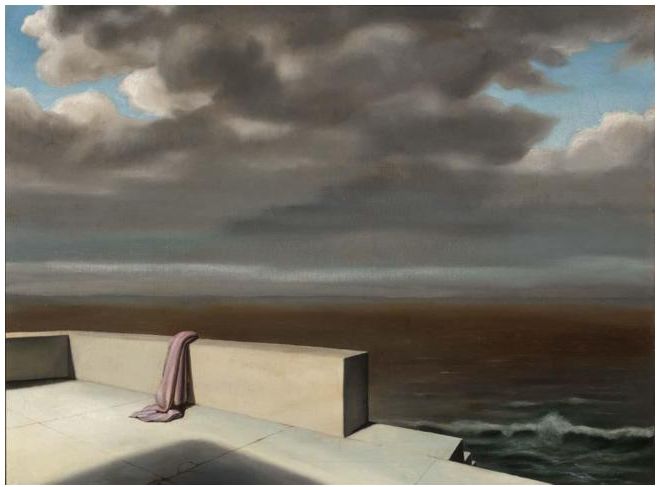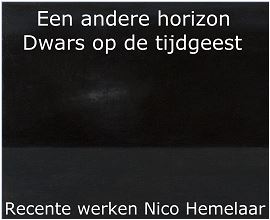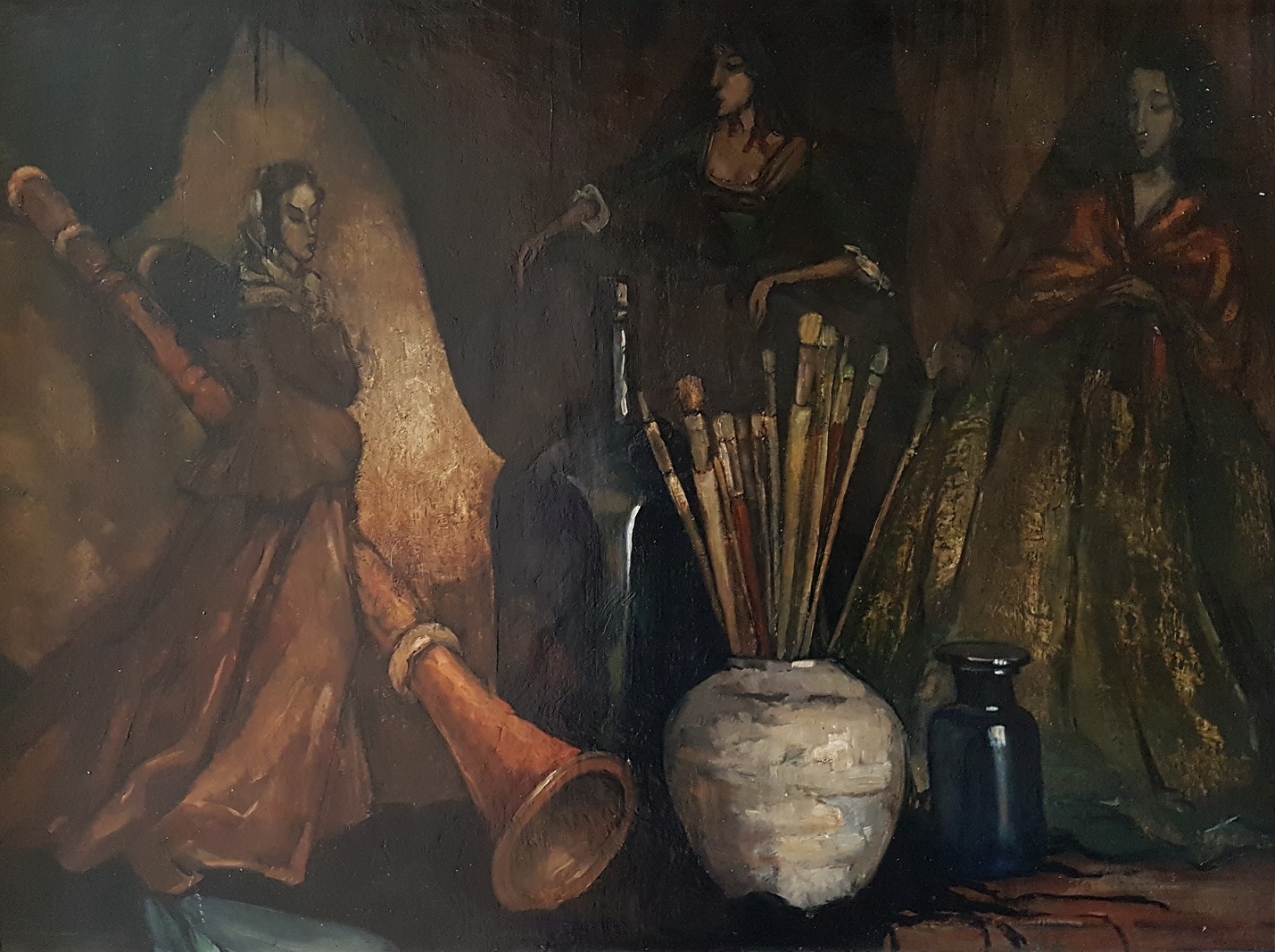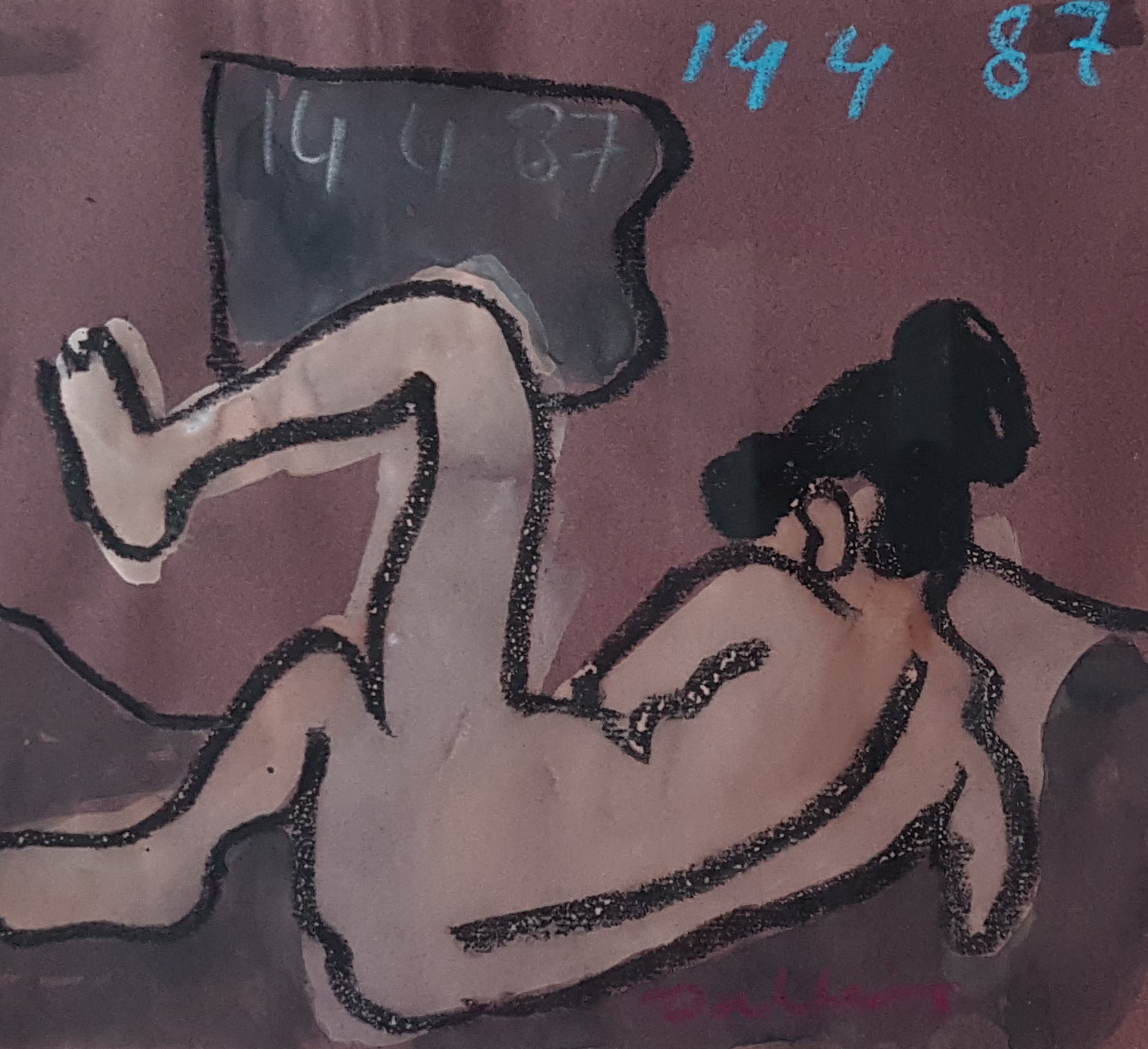
Beschrijving
DESCRIPTION: signed and dated 1935; signed on the stretcher. oil on canvas, in the original frame. PROVENANCE: G.H.M. Doudart de la Grée, Utrecht. G.H.M. Doudart de la Grée, Sprangcapelle. EXHIBITED: Utrecht, Centraal Museum, Jubileum-Tentoonstelling van werken van leden ter gelegenheid van het 140-jarig bestaan van het Genootschap Kunstliefde 1807-1947, 1947, no. 134. The Hague, Pulchri Studio, Tentoonstelling van werk door leden van het Schilderkundig Genootschap Kunstliefde te Utrecht anno 1807, 1949, no. 63. Utrecht, Grafisch Gezelschap De Luis, J.H. Moesman, 1963, no. 13. Amsterdam, Kabinet Floret, Tentoonstelling van Schilderijen van J.H. Moesman, 1966, no. 12. Eindhoven, De Zonnewijzer, Vrienden om Jaap Wagemaker, 1973, no. 36, illustrated. Laren, Singer Museum, Moesman: Schilderijen, klavecimbel en tekeningen, 1993, no. 20. LITERATURE AND REFERENCES: H. de Vries a.o., Peilingen naar het wezen van de Nederlandse Surrealist Moesman in een poging hem voor het nageslacht te bewaren, Utrech 1971, p. 45, no. 20, illustrated. O. Egberts, in: Jong Holland 9/3, p. 9, illustrated L. Brons, B. van Rossum a.o. , Moesman: Een compleet overzicht in beeld van alle olieverfschilderijen en het klavecimbel van de surrealist J.H. Moesman, Amsterdam 1993, p. 55,56, no.20, illustrated H. de Vries, Van hoegenaamd geen waarde: J.H. Moesman en de publiciteit, Enkhuizen 1994, no. 20 A. Petersen a.o., Moesman, Zwolle 1998, p. 133, 175, no. 22, illustrated in colour CATALOGUE NOTE: Johannes Hendrikus Moesman was born in 1909 in Utrecht. He was the only child of the printer and renowned calligrapher J. A. Moesman and D.H.J. van Houten. Although his father stimulated the boy’s ambitions to become an artist and sent him to the evening classes of the local academies, Moesman is considered to be a self-taught painter. After working with his father in the print shop he became an employee at the Dutch National Railways in 1925 and stayed there until he retired. In the period of Moesman’s youth Utrecht had a blooming artistic climate with people like Otto van Rees and the circle around Theo van Doesburg, including the development of the famous Rietveld-Schröder house in 1924. In 1928 Moesman came into contact with surrealism through an exhibition at gallery Nord in Utrecht. The owner, Willem Wagenaar, sold the surrealist magazines Variétés and Sélection and also works by famous surrealist painters. Through Wagenaar, Moesman became aware of the ideas and theories behind the paintings and saw works by Salvador Dali and Rene Magritte, whose work became a lifetime inspiration. Moesman became the foremost famous surrealistic painter Holland has ever known. His paintings were so impressive, that twice they were removed from public exhibitions, because the authorities were afraid of the public reaction. According to the theories of the surrealistic movement as written down by Andre Breton, surrealistic paintings should come from the subconscious. And although the pictures should be open to a variety of analysis, it’s tempting to give this landscape a rather personal interpretation, referring to the history of Moesman’s personal life. In Vloed (Flood) the floor of the spotless white terrace shows a crack in one of the slaps and a dark shadow is hanging over it. The pink drape over the balustrade seems to be forsaken and the wave on the lower right makes a splash like something or someone is breaking it. The dark red-brown sea and sky above give the whole picture a gloomy atmosphere. The picture looks like a film still; but we just missed the action. For the spectator it is an intriguing scene; we want to know what has happened, but Moesman choose to leave us guessing. So time and again we keep watching the painting trying to find the key to solve its mystery. Interesting to note is that Moesman used the same type of frame for this landscape as Magritte’s used for his painting Les charmes du paysage from 1929 – which depicts an empty frame with the tag “paysage”. Also the elements of breaking waves and stairs can be found in other works of that period by Magritte. Moesman made no secret that he used photographs for his paintings besides making sketches. This was also the case in Vloed. For the wave at the lower left bottom of the painting Moesman used a photograph of a similar wave that he kept in his archive. What’s also remarkable is the fact that this was one of the first two paintings Moesman ever sold. The work also dates from the most prolific period of his career, which culminated in his most famous painting Het gerucht (The rumour) of 1935. Mr. G. Smilda and Ms. G.H.M. Doudart de la Grée were the first buyers of Moesman’s paintings. Smilda and Doudart at that time ran a small shop in Utrecht and were the centre of a group of artists and anarchists to which also Moesman belonged before the second World War. Ms. Doudart de la Grée bought this painting before her marriage, and the work has not left the family until now.Details
- Databanknummer:
- 49324
- Lotnummer:
- -
- Advertentietype
- Archief
- Instelling:
- Sotheby's
- Veilingdatum:
- -
- Veilingnummer:
- -
- Stad
- -
- Limietprijs
- -
- Aankoopprijs
- -
- Verkoopprijs
- -
- Hamerprijs
- -
- Status
- Verkocht
Technische details
- Kunstvorm:
- Schilder- en Tekenkunst
- Technieken:
- Olieverf
- Dragers:
- Doek
- Lengte:
- 50 cm
- Breedte:
- 66 cm
- Hoogte:
- -
- Oplage:
Beschrijving
DESCRIPTION: signed and dated 1935; signed on the stretcher. oil on canvas, in the original frame. PROVENANCE: G.H.M. Doudart de la Grée, Utrecht. G.H.M. Doudart de la Grée, Sprangcapelle. EXHIBITED: Utrecht, Centraal Museum, Jubileum-Tentoonstelling van werken van leden ter gelegenheid van het 140-jarig bestaan van het Genootschap Kunstliefde 1807-1947, 1947, no. 134. The Hague, Pulchri Studio, Tentoonstelling van werk door leden van het Schilderkundig Genootschap Kunstliefde te Utrecht anno 1807, 1949, no. 63. Utrecht, Grafisch Gezelschap De Luis, J.H. Moesman, 1963, no. 13. Amsterdam, Kabinet Floret, Tentoonstelling van Schilderijen van J.H. Moesman, 1966, no. 12. Eindhoven, De Zonnewijzer, Vrienden om Jaap Wagemaker, 1973, no. 36, illustrated. Laren, Singer Museum, Moesman: Schilderijen, klavecimbel en tekeningen, 1993, no. 20. LITERATURE AND REFERENCES: H. de Vries a.o., Peilingen naar het wezen van de Nederlandse Surrealist Moesman in een poging hem voor het nageslacht te bewaren, Utrech 1971, p. 45, no. 20, illustrated. O. Egberts, in: Jong Holland 9/3, p. 9, illustrated L. Brons, B. van Rossum a.o. , Moesman: Een compleet overzicht in beeld van alle olieverfschilderijen en het klavecimbel van de surrealist J.H. Moesman, Amsterdam 1993, p. 55,56, no.20, illustrated H. de Vries, Van hoegenaamd geen waarde: J.H. Moesman en de publiciteit, Enkhuizen 1994, no. 20 A. Petersen a.o., Moesman, Zwolle 1998, p. 133, 175, no. 22, illustrated in colour CATALOGUE NOTE: Johannes Hendrikus Moesman was born in 1909 in Utrecht. He was the only child of the printer and renowned calligrapher J. A. Moesman and D.H.J. van Houten. Although his father stimulated the boy’s ambitions to become an artist and sent him to the evening classes of the local academies, Moesman is considered to be a self-taught painter. After working with his father in the print shop he became an employee at the Dutch National Railways in 1925 and stayed there until he retired. In the period of Moesman’s youth Utrecht had a blooming artistic climate with people like Otto van Rees and the circle around Theo van Doesburg, including the development of the famous Rietveld-Schröder house in 1924. In 1928 Moesman came into contact with surrealism through an exhibition at gallery Nord in Utrecht. The owner, Willem Wagenaar, sold the surrealist magazines Variétés and Sélection and also works by famous surrealist painters. Through Wagenaar, Moesman became aware of the ideas and theories behind the paintings and saw works by Salvador Dali and Rene Magritte, whose work became a lifetime inspiration. Moesman became the foremost famous surrealistic painter Holland has ever known. His paintings were so impressive, that twice they were removed from public exhibitions, because the authorities were afraid of the public reaction. According to the theories of the surrealistic movement as written down by Andre Breton, surrealistic paintings should come from the subconscious. And although the pictures should be open to a variety of analysis, it’s tempting to give this landscape a rather personal interpretation, referring to the history of Moesman’s personal life. In Vloed (Flood) the floor of the spotless white terrace shows a crack in one of the slaps and a dark shadow is hanging over it. The pink drape over the balustrade seems to be forsaken and the wave on the lower right makes a splash like something or someone is breaking it. The dark red-brown sea and sky above give the whole picture a gloomy atmosphere. The picture looks like a film still; but we just missed the action. For the spectator it is an intriguing scene; we want to know what has happened, but Moesman choose to leave us guessing. So time and again we keep watching the painting trying to find the key to solve its mystery. Interesting to note is that Moesman used the same type of frame for this landscape as Magritte’s used for his painting Les charmes du paysage from 1929 – which depicts an empty frame with the tag “paysage”. Also the elements of breaking waves and stairs can be found in other works of that period by Magritte. Moesman made no secret that he used photographs for his paintings besides making sketches. This was also the case in Vloed. For the wave at the lower left bottom of the painting Moesman used a photograph of a similar wave that he kept in his archive. What’s also remarkable is the fact that this was one of the first two paintings Moesman ever sold. The work also dates from the most prolific period of his career, which culminated in his most famous painting Het gerucht (The rumour) of 1935. Mr. G. Smilda and Ms. G.H.M. Doudart de la Grée were the first buyers of Moesman’s paintings. Smilda and Doudart at that time ran a small shop in Utrecht and were the centre of a group of artists and anarchists to which also Moesman belonged before the second World War. Ms. Doudart de la Grée bought this painting before her marriage, and the work has not left the family until now.Aangeboden kunst
Een selectie uit ons kunstaanbod


.JPG)

.jpg)